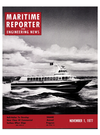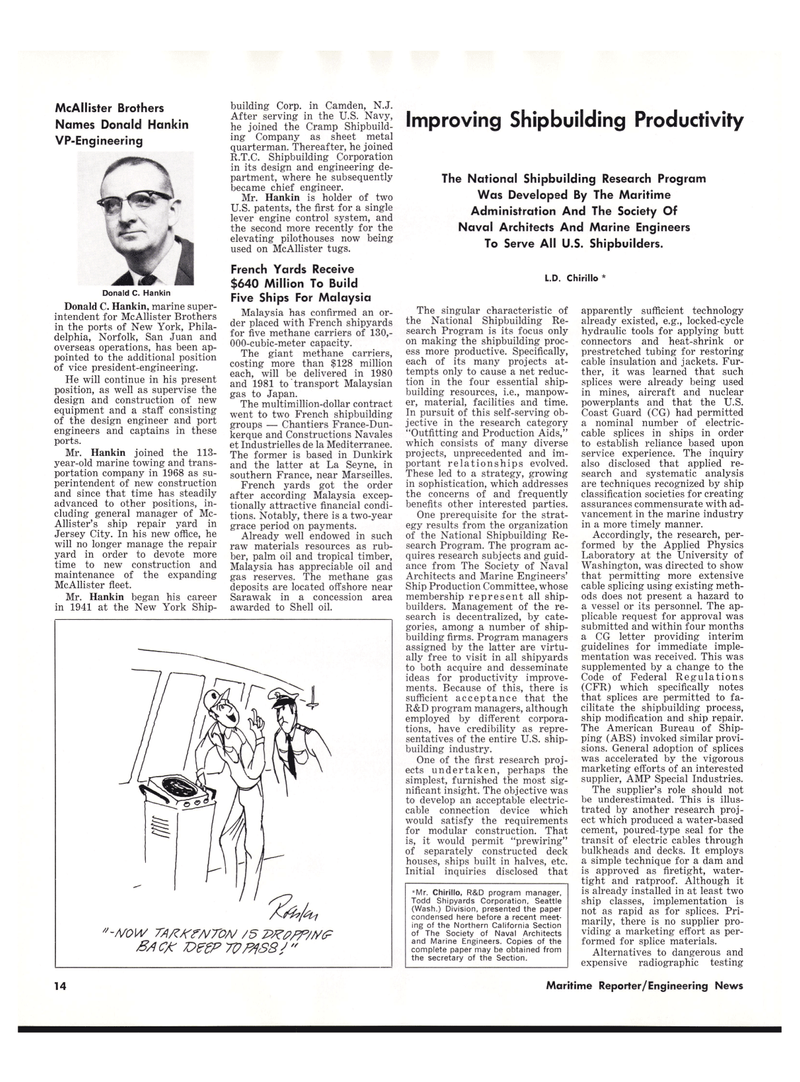
Page 14: of Maritime Reporter Magazine (November 1977)
Read this page in Pdf, Flash or Html5 edition of November 1977 Maritime Reporter Magazine
McAllister Brothers
Names Donald Hankin
VP-Engineering
Donald C. Hankin
Donald C. Hankin, marine super- intendent for McAllister Brothers in the ports of New York, Phila- delphia, Norfolk, San Juan and overseas operations, has been ap- pointed to the additional position of vice president-engineering.
He will continue in his present position, as well as supervise the design and construction of new equipment and a staff consisting of the design engineer and port engineers and captains in these ports.
Mr. Hankin joined the 113- year-old marine towing and trans- portation company in 1968 as su- perintendent of new construction and since that time has steadily advanced to other positions, in- cluding general manager of Mc-
Allister's ship repair yard in
Jersey City. In his new office, he will no longer manage the repair yard in order to devote more time to new construction and maintenance of the expanding
McAllister fleet.
Mr. Hankin began his career in 1941 at the New York Ship- building Corp. in Camden, N.J.
After serving in the U.S. Navy, he joined the Cramp Shipbuild- ing Company as sheet metal quarterman. Thereafter, he joined
R.T.C. Shipbuilding Corporation in its design and engineering de- partment, where he subsequently became chief engineer.
Mr. Hankin is holder of two
U.S. patents, the first for a single lever engine control system, and the second more recently for the elevating pilothouses now being used on McAllister tugs.
French Yards Receive $640 Million To Build
Five Ships For Malaysia
Malaysia has confirmed an or- der placed with French shipyards for five methane carriers of 130,- 000-cubic-meter capacity.
The giant methane carriers, costing more than $128 million each, will be delivered in 1980 and 1981 to transport Malaysian gas to Japan.
The multimillion-dollar contract went to two French shipbuilding groups — Chantiers France-Dun- kerque and Constructions Navales et Industrielles de la Mediterranee.
The former is based in Dunkirk and the latter at La Seyne, in southern France, near Marseilles.
French yards got the order after according Malaysia excep- tionally attractive financial condi- tions. Notably, there is a two-year grace period on payments.
Already well endowed in such raw materials resources as rub- ber, palm oil and tropical timber,
Malaysia has appreciable oil and gas reserves. The methane gas deposits are located offshore near
Sarawak in a concession area awarded to Shell oil. "-Arow TA/ZKFNTOM /S B/ic/? Tvmssj "
Improving Shipbuilding Productivity
The National Shipbuilding Research Program
Was Developed By The Maritime
Administration And The Society Of
Naval Architects And Marine Engineers
To Serve All U.S. Shipbuilders.
L.D. Chirillo *
The singular characteristic of the National Shipbuilding Re- search Program is its focus only on making the shipbuilding proc- ess more productive. Specifically, each of its many projects at- tempts only to cause a net reduc- tion in the four essential ship- building resources, i.e., manpow- er, material, facilities and time.
In pursuit of this self-serving ob- jective in the research category "Outfitting and Production Aids," which consists of many diverse projects, unprecedented and im- portant relationships evolved.
These led to a strategy, growing in sophistication, which addresses the concerns of and frequently benefits other interested parties.
One prerequisite for the strat- egy results from the organization of the National Shipbuilding Re- search Program. The program ac- quires research subjects and guid- ance from The Society of Naval
Architects and Marine Engineers'
Ship Production Committee, whose membership represent all ship- builders. Management of the re- search is decentralized, by cate- gories, among a number of ship- building firms. Program managers assigned by the latter are virtu- ally free to visit in all shipyards to both acquire and desseminate ideas for productivity improve- ments. Because of this, there is sufficient acceptance that the
R&D program managers, although employed by different corpora- tions, have credibility as repre- sentatives of the entire U.S. ship- building industry.
One of the first research proj- ects undertaken, perhaps the simplest, furnished the most sig- nificant insight. The objective was to develop an acceptable electric- cable connection device which would satisfy the requirements for modular construction. That is, it would permit "prewiring" of separately constructed deck houses, ships built in halves, etc.
Initial inquiries disclosed that *Mr. Chirillo, R&D program manager,
Todd Shipyards Corporation, Seattle (Wash.) Division, presented the paper condensed here before a recent meet- ing of the Northern California Section of The Society of Naval Architects and Marine Engineers. Copies of the complete paper may be obtained from the secretary of the Section. apparently sufficient technology already existed, e.g., locked-cycle hydraulic tools for applying butt connectors and heat-shrink or prestretched tubing for restoring cable insulation and jackets. Fur- ther, it was learned that such splices were already being used in mines, aircraft and nuclear powerplants and that the U.S.
Coast Guard (CG) had permitted a nominal number of electric- cable splices in ships in order to establish reliance based upon service experience. The inquiry also disclosed that applied re- search and systematic analysis are techniques recognized by ship classification societies for creating assurances commensurate with ad- vancement in the marine industry in a more timely manner.
Accordingly, the research, per- formed by the Applied Physics
Laboratory at the University of
Washington, was directed to show that permitting more extensive cable splicing using existing meth- ods does not present a hazard to a vessel or its personnel. The ap- plicable request for approval was submitted and within four months a CG letter providing interim guidelines for immediate imple- mentation was received. This was supplemented by a change to the
Code of Federal Regulations (CFR) which specifically notes that splices are permitted to fa- cilitate the shipbuilding process, ship modification and ship repair.
The American Bureau of Ship- ping (ABS) invoked similar provi- sions. General adoption of splices was accelerated by the vigorous marketing efforts of an interested supplier, AMP Special Industries.
The supplier's role should not be underestimated. This is illus- trated by another research proj- ect which produced a water-based cement, poured-type seal for the transit of electric cables through bulkheads and decks. It employs a simple technique for a dam and is approved as firetight, water- tight and ratproof. Although it is already installed in at least two ship classes, implementation is not as rapid as for splices. Pri- marily, there is no supplier pro- viding a marketing effort as per- formed for splice materials.
Alternatives to dangerous and expensive radiographic testing 14 Maritime Reporter/Engineering • News

 13
13

 15
15
